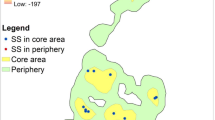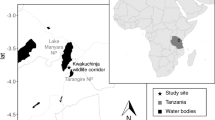Abstract
Sleeping site selection is an important aspect of the behavioral biology of primates. Comparison of different habitats for the same species in this context enhances understanding of their adaptation to altered environments. We collected data on sleep-related behaviors for 6 groups of Francois’s langur (Trachypithecus francoisi) in two habitats, in Mayanghe National Nature Reserve, Guizhou, China. Regardless of habitat, all sleeping sites were located in areas of steep terrain of ≥60°. In undisturbed habitat, sleeping sites were located only in evergreen broadleaf forest with rock caves and crevices surrounded mainly by a vegetation layer of shrub + rock. In disturbed habitat, sleeping sites were also located in mixed evergreen and deciduous broadleaf forest and in grassland, including rock caves, crevices, and pits, surrounded mainly by arbor + shrub and shrub + rock. Wild food availability was higher in undisturbed habitat than disturbed habitat, but food abundance around sleeping sites was lower. Water sources included river and seasonal gully or pond. There was strong positive correlation between use of sleeping sites away from the river valley and occurrence of seasonal water sources. The number of sleeping sites varied across groups, numbering 6, 7, and 10 for three specific groups. Few sleeping sites were used all year round. Six consecutive nights was the longest recorded run. Francois’s langurs’ sleeping habits differed between two habitats. In undisturbed habitat, minimizing predation risk appeared to predominate, expressed by choosing steep terrain, open visual field, and inconspicuous presleeping behavior. In disturbed habitat, along with predation avoidance, food resources may strongly influence sleeping site selection, as demonstrated by the richer food abundance and greater foraging activity around the site. Finally, water resources may influence choice of sites distant from the river; such sites were used less frequently during water shortages.

Similar content being viewed by others
References
Altmann J (1974a) Observational study of behavior: sampling methods. Behaviour 49:227–262
Altmann SA (1974b) Baboons, space, time and energy. Am Zool 14:221–248
Anderson JR (1998) Sleep, sleeping sites, and sleep-related activities: awakening to their significance. Am J Primatol 46:63–75
Barrett L, Gaynor D, Rendall D, Mitchell D, Henzi SP (2004) Habitual cave use and thermoregulation in chacma baboon (Papio hamadryas ursinus). J Hum Evol 46:215–222
Chapman CA (1989) Spider monkey sleeping sites: use and availability. Am J Primatol 18:53–60
Chapman CA, Chapman LJ, Mclaughlin RL (1989) Multiple central place foraging by spider monkeys: travel consequences of using many sleeping sites. Oecologia 79:506–511
Chen ZR, Luo Y, Wang SX (2001) A preliminary study on home range of Francois’s langur. Guizhou For Sci Technol 29:34–37
Cottam G, Curtis JT (1956) The use of distance measures in phytosociological sampling. Ecology 37:451–460
Cyril CG, Ding W (2006) An observation of Francois’s langur using caves at Mayanghe National Nature Reserve, Guizhou, China. Zool Res 27:558–560
Di Bitetti MS, Vidal EML, Baldovino MC, Benesovsky V (2000) Sleeping site preferences in Tufted Capuchin Monkeys (Cebus apella nigritus). Am J Primatol 50:257–274
Fan PF, Jiang XL (2008) Sleeping sites, sleeping trees, and sleep-related behaviors of black crested gibbons (Nomascus concolor jingdongensis) at Mt. Wuliang, Central Yunnan, China. Am J Primatol 70:153–160
Fujimori T (2001) Ecological and silvicultural strategies for sustainable forest management. Amsterdam, Elsevier, 398 pp
Hamilton WJI (1982) Baboon sleeping site preferences and relationships to primate grouping patterns. Am J Primatol 3:41–53
Hausfater G, Meade BJ (1982) Alternation of sleeping groves by yellow baboons (Papio cynocephalus) as a strategy for parasite avoidance. Primates 23:287–297
Haya G, Zamma K, Hayaishi S, Yoshihiro S, Tsuriya Y, Sugaya S, Kanaoka MM, Hayakawa S, Takahata Y (2005) Compositions of food availability and group density of Japanese macaques in primary, naturally regenerated, and plantation forest. Am J Primatol 66:245–262
Heymann EW (1995) Sleeping habits of tamarins, Saguinus mystax and Saguinus fuscicollis (Mammalia; Primates; Callitrichidae), in north-eastern Peru. J Zool 237:211–226
Huang CM, Wei FW, Li M, Li YB (2003) Sleeping cave selection, activity pattern and time budget of white-headed langurs. Int J Primtol 24:813–824
Huang XH, Li YB, Huang CM, Huang ZH, Zhou QH (2010) Food water content of Francois’s langur (Trachypithecus francoisi) in Fusui, Guangxi Province. J Sichuan Norm Univ 33:243–246
Kappeler PM (1998) Nests, tree holes, and the evolution of primate life histories. Am J Primatol 46:7–33
Kinzey WG, Wright PC (1982) Grooming behavior in the titi monkey (Callicebus torquatus). Am J Primatol 3:267–275
Kowalewski M, Zunino GE (2005) The parasite behavior hypothesis and the use of sleeping sites by black howler monkeys (Alouatta caraya) in a discontinuous forest. Neotrop Primates 13:22–26
Lechowicz MJ (1982) The sampling characteristics of electivity indices. Oecologia 52:22–30
Li MJ (1994) Wildlife resources in Guizhou Province. China Forestry Publishing House, Beijing, pp 25–27
Li YB, Huang CM, Ding P, Tang Z, Wood C (2007) Dramatic decline of Francois’s langur Trachypithecus francoisi in Guangxi Province, China. Oryx 41:38–43
Liu ZH, Zhao QK (2004) Sleeping sites of Rhinopithecus bieti at Mt. Fuhe, Yunnan. Primates 45:241–248
Luo Y (2007) The management effectiveness in Mayanghe National Nature Reserve, Guizhou Province, China. PhD dissertation, Northeast Forestry University, Harbin, 32 pp
Luo Y, Chen ZR, Wang SX (2000) Observations on the food habitat of Presbytis francoisi in Mayanghe Region, Guizhou Province. Chin J Zool 35:44–49
Luo Y, Zhang MH, Ma JZ, Wang SX, Zhang SS, Wu AK (2005) Time budget of daily activity of Francois’s langur (Trachypithecus francoisi francoisi) in Guizhou Province. Acta Theriol Sin 25:156–162
Luo Y, Zhang MH, Ma JZ, Wu AK, Wang SX, Zhang SS (2007) Time budget of daily activity of Francois’s langur (Trachypithecus francoisi francoisi) in disturbed habitat. Acta Ecol Sin 27:1715–1722
Mendes Pontes AR, Soares ML (2005) Sleeping sites of common marmosets (Callithrix jacchus) in defaunated urban forest fragments: a strategy to minimize food intake. J Zool Lond 266:55–63
Nishida T (1987) Local traditions and cultural transmission. In: Smuts BB, Cheney DL, Seyfarth RM, Wrangham RW, Struhsaker TT (eds) Primate societies. University of Chicago Press, Chicago, pp 197–209
Radespiel U, Ehresmann P, Zimmermann E (2003) Species-specific usage of sleeping sites in two sympatric mouse lemur species (Microcebus murinus and M. ravelobensis) in northwestern Madagascar. Am J Primatol 59:139–151
Reichard U (1998) Sleeping sites, sleeping places, and presleep behavior of gibbon (Hylobates lar). Am J Primatol 46:35–62
Richard TD, Robert WE (1999) Sleeping site selection by the Golden-handed tamarin Saguinus midas midas: the role of predation risk, proximity to feeding sites, and territorial defense. Ethology 105:1035–1051
Strier KB (2006) Primate behavioral ecology. Allyn and Bacon, USA, pp 120–121
Treves A (2002) Predicting predation risk for foraging, arboreal monkeys. In: Miller LE (ed) Eat or be eaten: predator sensitive foraging among primates. Cambridge University Press, Cambridge, pp 222–241
von Hippel FA (1996) Interactions between overlapping multimale groups of black and white colobus monkeys (Colobus guereza) in the Kakamega Forest, Kenya. Am J Primatol 38:193–209
Wang SL (2008) Home range and habitat characteristics of Francois’s langur (Trachypithecus francoisi) in Mayanghe National Nature Reserve, China. PhD dissertation, Beijing Forestry University, Beijing, pp 23–31, 87
Acknowledgments
This research was funded by the Ministry of Science and Technology, P. R. China (Grants No. 2008BADB0B01). All research methods adhered to Chinese legal requirements. We are grateful to the staff of Mayanghe National Nature Reserve for their support and help. We thank Mr. Qikun Zhao, Dr. William Bleisch, and Mr. Paul Insua-Cao for their valuable comments and revisions of English. We are grateful for the meticulous work of the anonymous editors. We are also indebted to Ms. Xiao Yanqing and Dr. Xing Shaohua for their help in providing valuable references. Thanks are also given to the anonymous reviewers for their very useful and detailed comments.
Author information
Authors and Affiliations
Corresponding author
About this article
Cite this article
Wang, S., Luo, Y. & Cui, G. Sleeping site selection of Francois’s langur (Trachypithecus francoisi) in two habitats in Mayanghe National Nature Reserve, Guizhou, China. Primates 52, 51–60 (2011). https://doi.org/10.1007/s10329-010-0218-2
Received:
Accepted:
Published:
Issue Date:
DOI: https://doi.org/10.1007/s10329-010-0218-2




